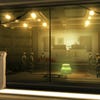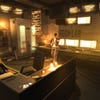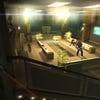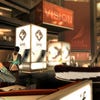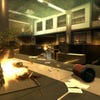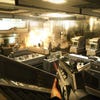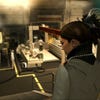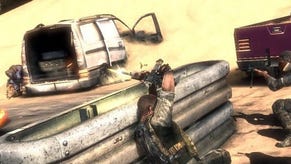Deus Ex: Human Revolution
Ten hours played. Your questions answered.
I murdered a tramp in a bleak cyberpunk future and I am unrepentant. I shot him in the face twice – once to watch him die, twice for a more pleasing ragdoll.
The boundaries of Deus Ex: Human Revolution cannot be measured by polite words about a brave new transhumanist future. They can be reached only through a pile of dead homeless people. The law courts may judge me, but history will not.
He was sitting on a bench at the wrong end of an alley where the patrolling cops couldn't see him. Unfortunately the noise of his dismissal put them on a heightened alert. The futuro-filth searched me out, and as I turned I found myself faced with two cops raising their weapons.
The first I used a fatal move on. I planted my augmented arm on his face and span his body until his head hang at an unruly angle. The second I dispatched with a bullet. I dragged all the bodies into the alley, and there they stayed as a permanent guilt-trip for the rest of my time in a PS3 vision of a near-future Detroit.
The fact you can so deliberately break the immersion in Deus Ex: Human Revolution, and the fact the game's systems (if not the storyline) will allow you to muck around in its near-future sandbox, mark it out as a true DX game.
Commit an atrocity (say, let off a Typhoon Explosive System in a crowd on the subway and watch bodies slo-mo cartwheel into the ceiling) and the police won't forget you – every time you return to the area they'll be on your case.
The story won't - and shouldn't - wrap itself around your new life as a serial killer. (Your IT specialist, Pritchard, will only pick up on the 'killing fields' you create in missions.) But all this is proof Eidos Montreal has created a game world open to experimentation.
In fact much of my time with the game was spent stacking boxes to help me jump up into areas I thought the developers wouldn't allow access to, throwing fire extinguishers at NPC heads and piling (an admittedly limited range) of objects on people's desks for nostalgic chuckles. Human Revolution is set in a rich, deep and beautiful world - but more importantly, it has been built as something to play within.
I'm a happy augmented bunny then, but in my last DX:HR preview I promised to answer some of the questions of EG readers.
Can their dreams come true too, even if none asked whether Adam Jensen could jump up and down on a mission-givers desk having just killed a vagrant? (He can!) Here, with apologies to those whose questions I've rudely ignored, are the answers.
"How open do the levels get? Not just in the cities, but also in the places you're not supposed to be." - TheTingler
It takes a while for Human Revolution to open out into the Detroit hub. There's a long conveyor belt Half-Life-style opening to get through first, then various missions that attach the tutorial stabilisers to DX's varied hacking, social, combat and stealth gameplay.
Once you're out and about, you'll have two or three missions on the boil within a hub that's comparatively large compared to those in other contemporary games. It's a little bigger, say, than a Mass Effect 2 planet. The open and lonely acreage you might have felt in the very first Deus Ex, however, is lacking – or at least it is in this map.
Primary locations to explore within Detroit include Sarif Industries itself, the local Limb clinic and the Police Station – all with computers to hack into, email to read and women's toilets to run in and out of.
Secondary locations (in answer to a question from thelatestmodel) will often be visited in the course of your investigations – but may well have room for exploration attached. At one point, for example, you meet up with a retired detective pulling a watchman shift in a block of flats. Once you're done with him you can happily trot upstairs and burgle the apartments he's guarding.
Don't expect a myriad of cubby-holes. Only one can be hacked into in this case. But there are certainly smaller non-plot reliant areas scattered around, if you look for them.


